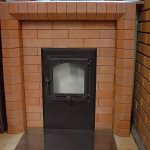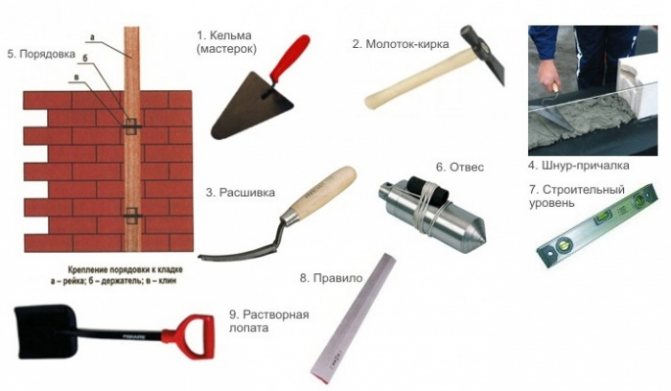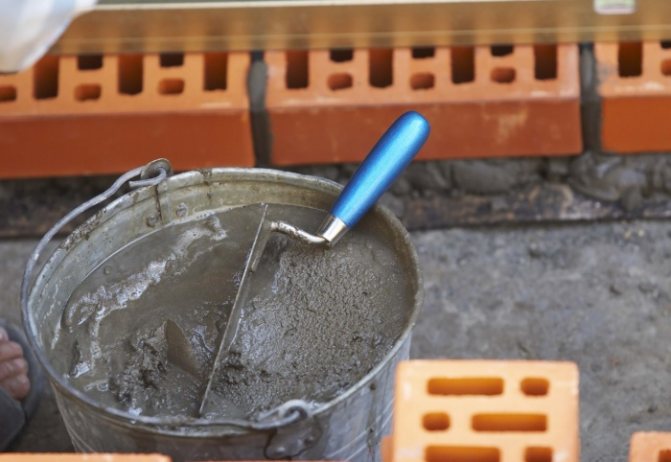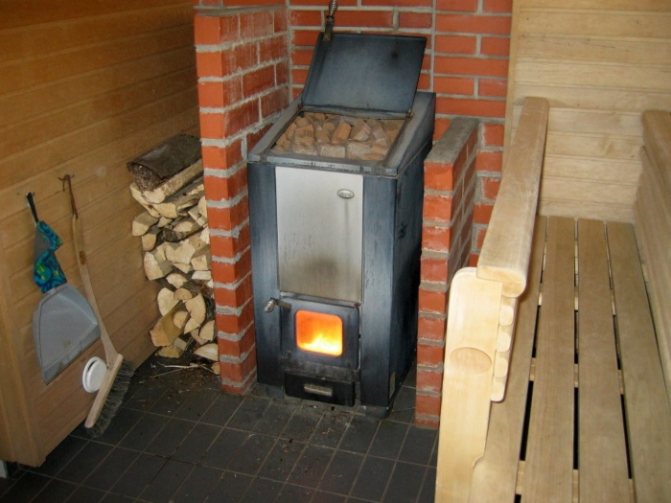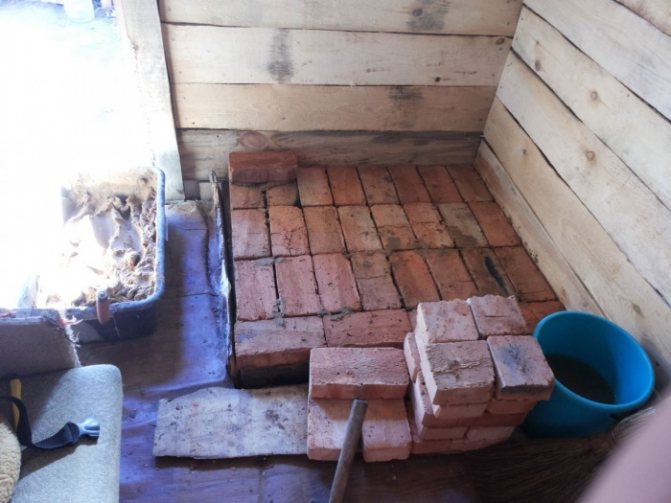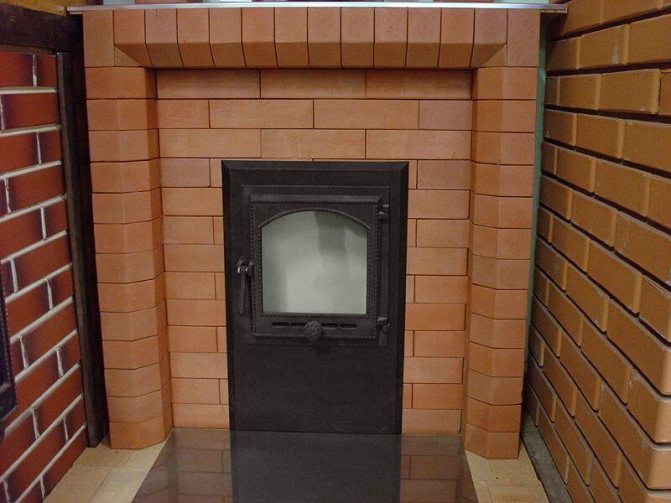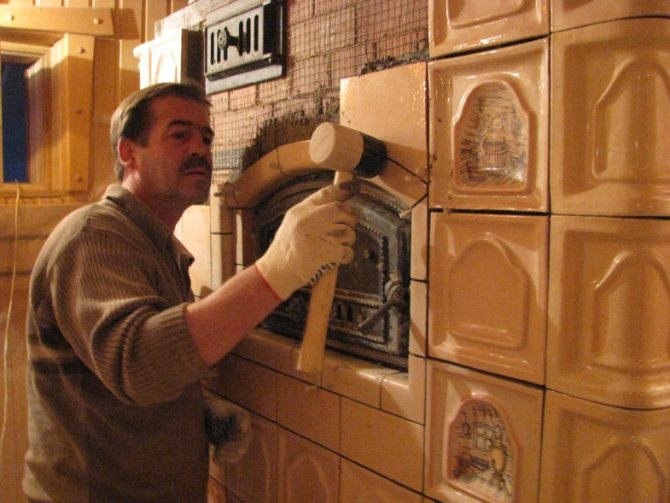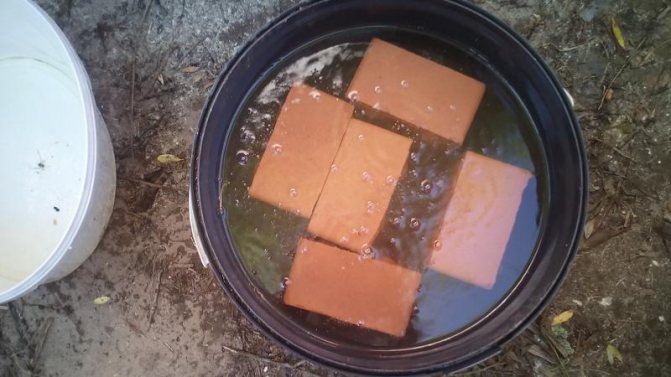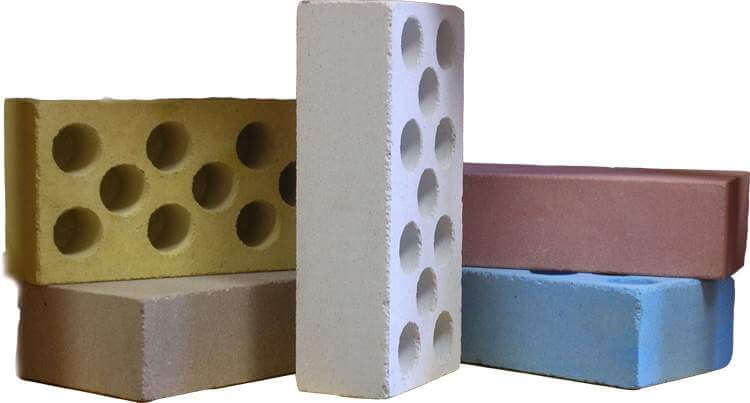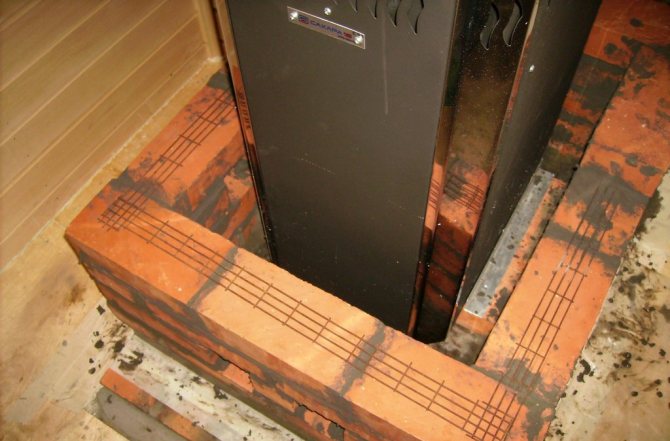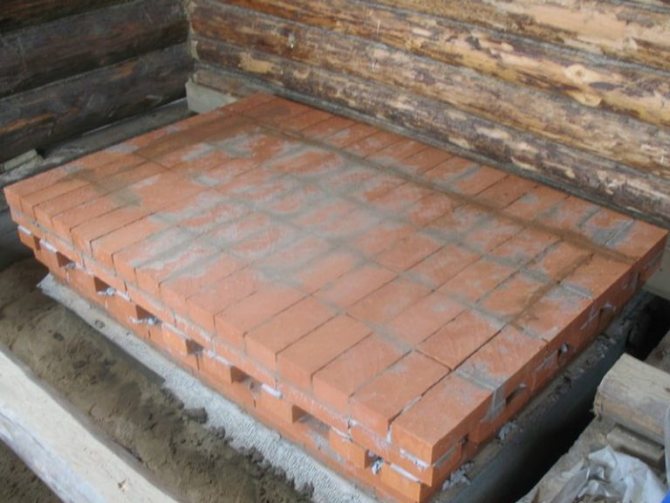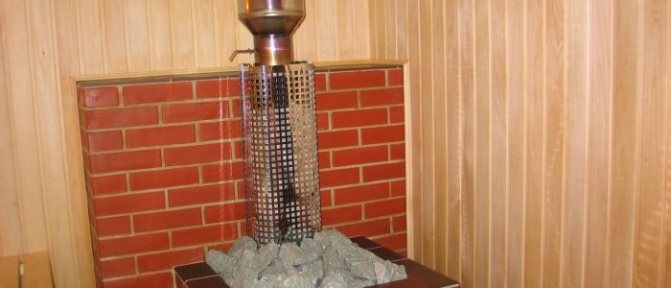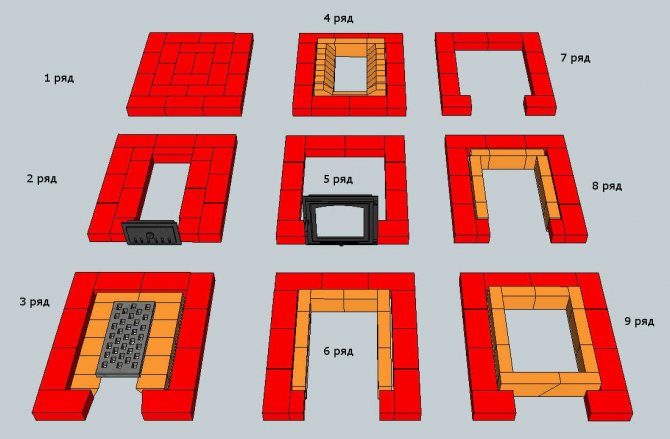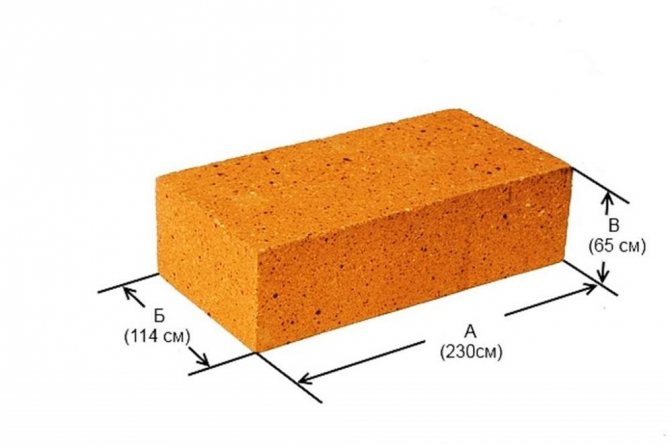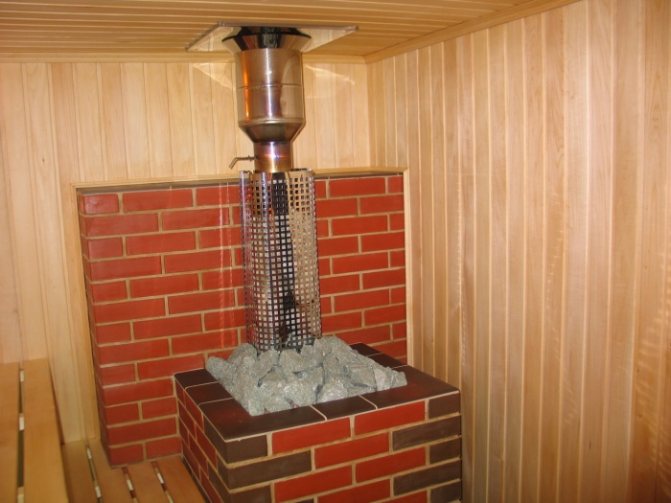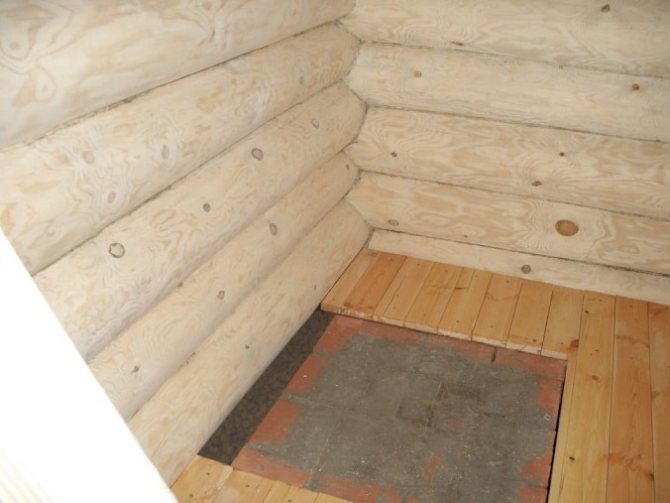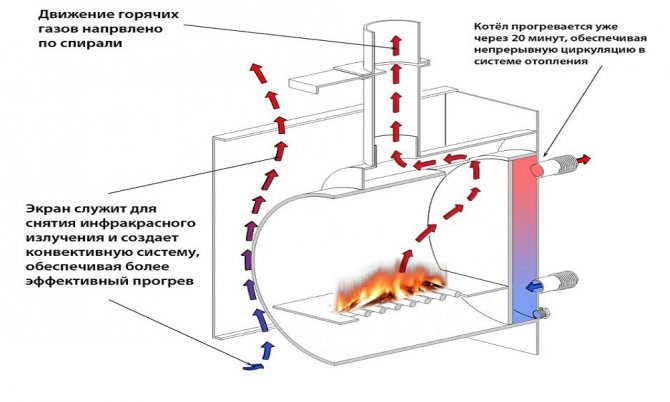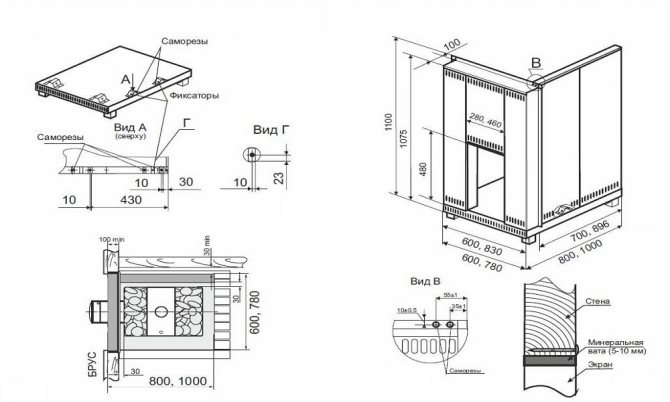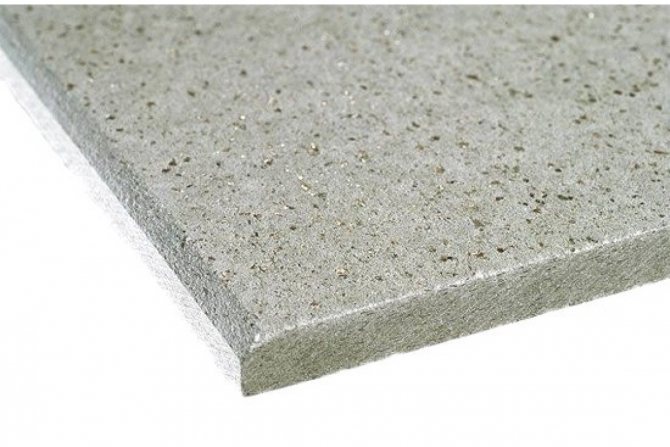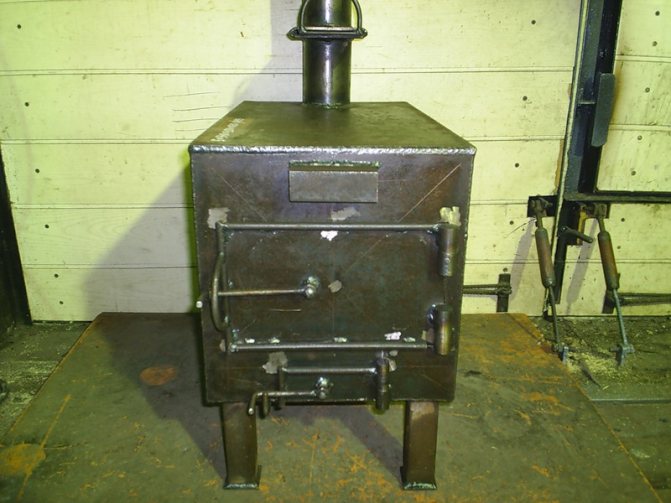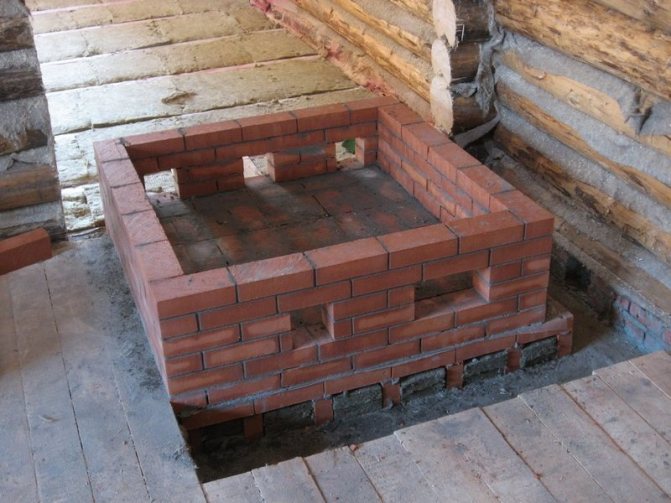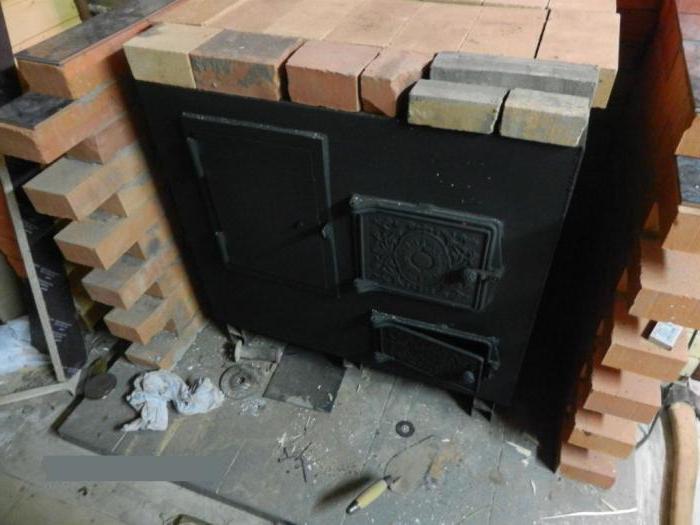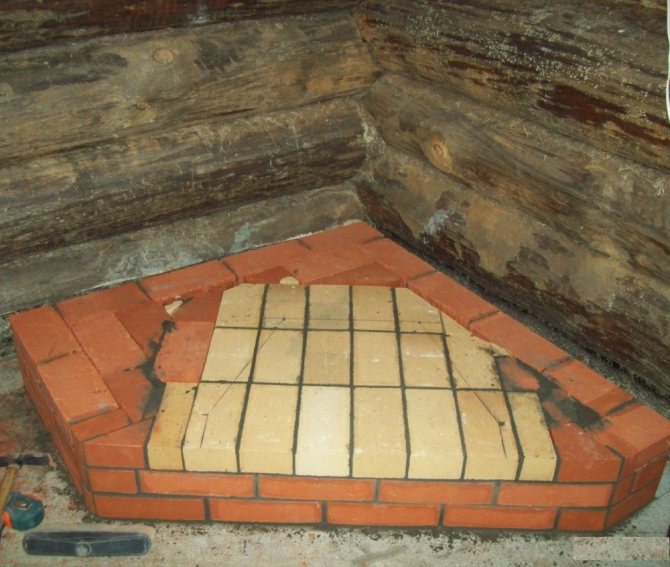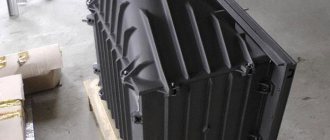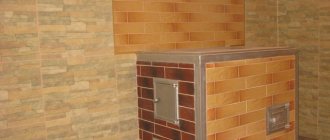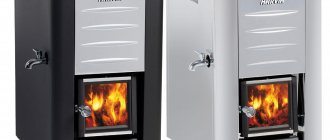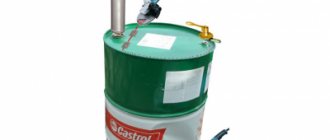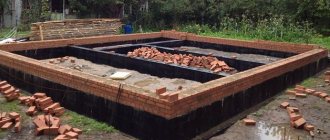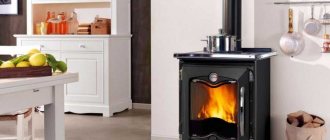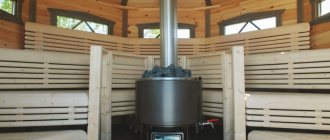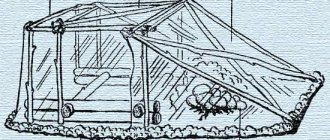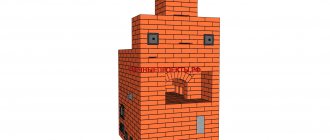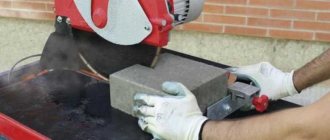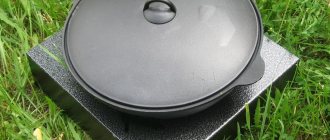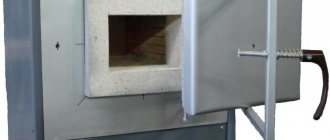Covering the stove in the bath with a brick is a very common technical move among the owners of metal bath stoves.
The fact is that, in addition to the obvious positive aspects, the use of devices made of metal for heating has its own obvious disadvantages. To correct such shortcomings, the operation of facing a similar furnace with a brick is called upon.
Foundation base for lining
The blocks used must have a weight of 3.8-4.2 kg. The total mass of the structure, together with the metal firebox, will require a solid foundation. After completion, the weight will be about a ton.
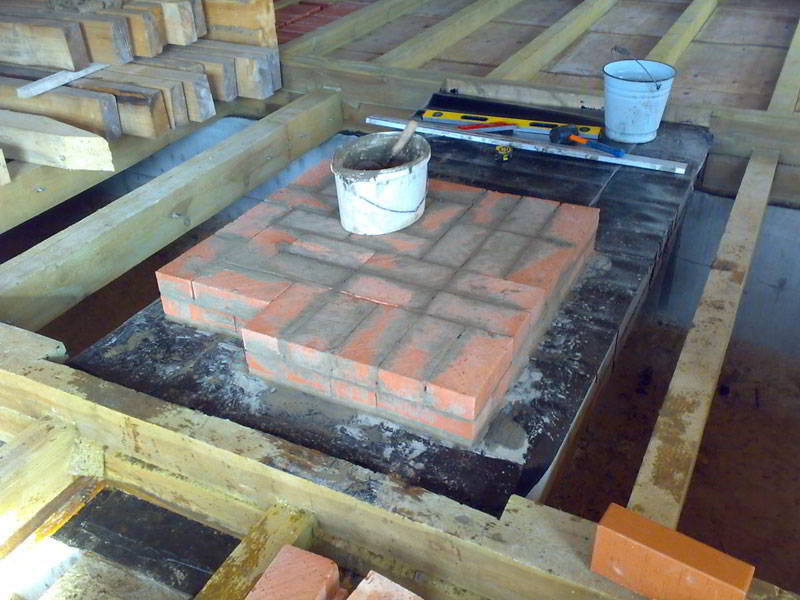
The procedure for arranging a strip foundation is as follows:
- Cut a square hole in the floor.
- Dig a pit up to half a meter deep into the ground.
- Fill the bottom with a layer of crushed stone (fraction 10-20 mm, thickness of the filling - 10-15 cm).
- Lay waterproofing film (thick polyethylene or roofing felt).
- Install (unfasten) the formwork along the perimeter.
- Install a reinforcement frame (steel or fiberglass) inside.
- Fill the cavity with concrete, the grade of which must be at least M200, class B15.
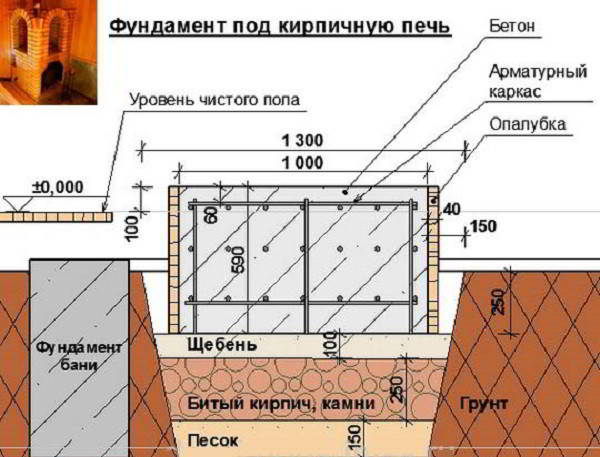

The height of the foundation, protruding above the ground surface, is 20 cm. It is “taken out” under the floor level with the help of a thermal insulation layer. It is laid out of heat-resistant bricks in a "solid" pattern. The solution is the same composition that will be applied later.
DIY cladding
To make the lining of the stove with your own hands, you need to prepare the materials, prepare the solution, make a solid foundation, and perform the lining. The finishing process has many features that must be taken into account when carrying out work.
Material preparation
The first stage is the preparation of materials. To do this, you need to buy the required amount of bricks. It is recommended to buy 10% more material than necessary. Additionally, you will need sand, cement, crushed stone, clay, dry mix for brickwork. For the manufacture of formwork, foundations, you need metal fittings, knitting wire, nails, self-tapping screws, wooden blocks, slats, boards.
Preparation of the solution
For the exterior decoration of a metal stove with a brick, it is necessary to prepare a solution. It is made from cement mixed with clay. The consistency of the solution should resemble thick sour cream. Moreover, he should not have lumps.
- Pour dry cement, clay into a metal container. You cannot fill in a large number of basic components at once, since the solution will be filled with a large number of lumps.
- Add water, start stirring the solution using a drill with a special nozzle.
- Gradually add clay, cement, until you get the required consistency.
When to start
The concrete curing period is 27 days. The thermal insulation layer is mounted a week after pouring, when the foundation has gained 60% of the prescribed indicator. You can load it on the 28th day. During this time, the base will acquire the ability to withstand the load, it will shrink, which will exclude distortion, cracking. Installation begins with putting the firebox in place.
The choice of material for the cover
Among the recommended types of bricks, the best are red ceramic or hollow fireclay. The latter is more expensive, but its use is mandatory if the gap between the walls of the firebox and the masonry is 2-4 cm, which will warm up to 400 C.
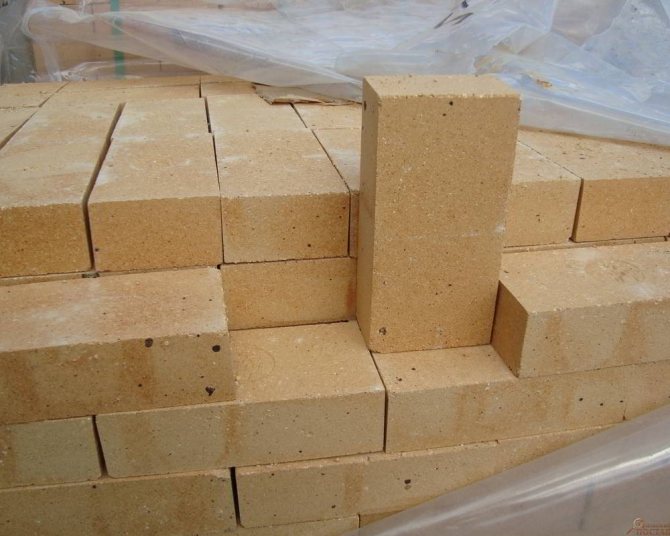

To use ceramic, a gap of 7-10 cm is required. Then it will warm up to 200, which is uncritical. The ventilation holes will solve the problem of overheating. This will reduce the cost of the design and speed up the heating of the bath when firing up.The ideal option is still fireclay, which was originally developed for high temperatures.
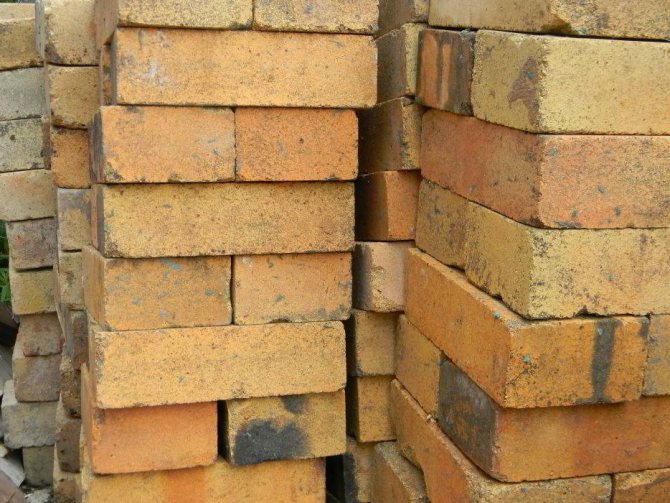

Solution manufacturing technology
Ready-made dry mixes for stoves and fireplaces are on sale. The packaging contains recommendations for preparation (mixing with water). To make your own masonry mixture for lining, you need to purchase:
- refractory chamotte clay;
- construction sand (fineness module 1-1.2);
- cement without slag content (M500 D0).
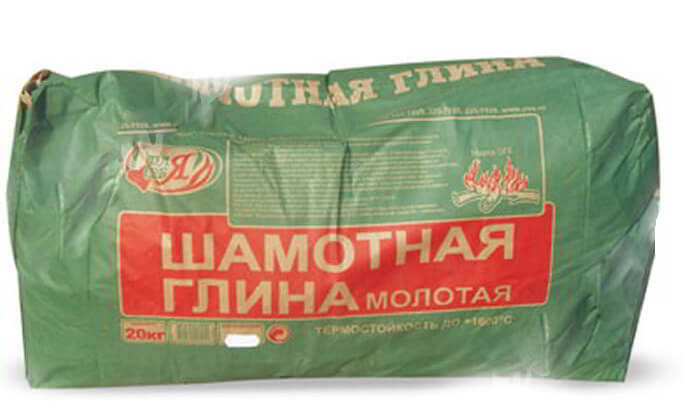

Sand and clay are sieved and exclude the ingress of crushed stone, clay impurities. The proportion of aggregates is 1: 1. The introduction of cement is optional, but desirable. It will be enough 0.5 kg for a 10-liter container of dry chamotte-sand mixture. After mixing the aggregates, pour in water. The volume is determined by the consistency of the finished solution (thick, plastic, does not stick to the trowel).
Brick selection
Not every material is suitable for oven cladding. A number of requirements are imposed on a brick. The stove heats up to high temperatures, which means that the brick must withstand such temperatures.
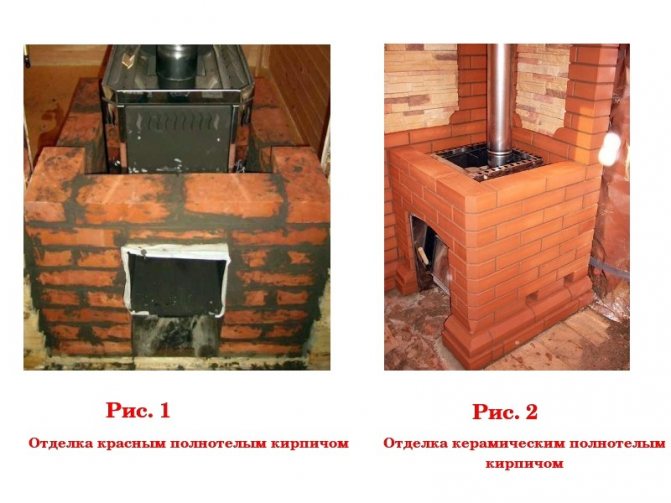

Fireclay bricks, heat-resistant alumina, clinker or refractory red are suitable. These species withstand high temperatures, they are full-bodied and will live with you for many years.
In no case can hollow bricks, silicate and slotted bricks be used. They are not resistant to high temperatures, they will not tolerate heat.
Fireclay bricks can be operated even when heated to over 1000 degrees. It is made on the basis of clay by firing and with the addition of chamotte chips. Fireclay brick, despite its light weight, is dense. And due to its light weight, it conducts heat faster than others.
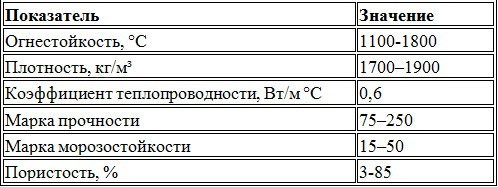

But the material is very expensive. Therefore, in order to save money, it is used for partial lining: it is used directly at the source of fire. Red refractory brick will cost several times less, as a result of which it is used much more often.
It is also made of clay. It can be used for full lining or only at the site of the fire. Red brick accumulates heat in itself and gives it away. Alumina is in demand due to its price and good characteristics.


Refractory, will withstand temperatures over 1000 degrees. Ideal for a bath, since it is not afraid of drops, which is important for an unheated room. Its popularity is also explained by its increased durability, cold water can be poured onto it in a heated state, which is liked by many sauna lovers. The material will last for more than a decade. Clinker bricks are not inferior in price to fireclay bricks, therefore they are used much less often. Withstands high temperatures, but the indicator is lower than that of the same fireclay. Appearance is equally important. The iron stove itself does not look aesthetically pleasing. Therefore, it is important to purchase quality material.
Review a few bricks before purchasing. There should be no irregularities or depressions. You can even measure them. There should be no deviations for bricks of the same batch of more than 2 mm.
You can also see a sectional view of the brick: it should be stain-free and well painted. Be sure to ask for quality certificates, if there are none, do not purchase anything from this store.
Types of masonry
In order to impose a brick on the iron stove in the bath, people who do not have the skills of a bricklayer are recommended to resort to laying in a "half brick" (flat).
The “quarter brick” technology, which involves laying blocks on the side edge, is suitable for those who have already encountered such work. There are two main clutches:
- Solid. Does not include air circulation holes. Suitable for the subsequent decorative cladding of the stove with facing materials.
- "In detente". Provides ventilation holes.
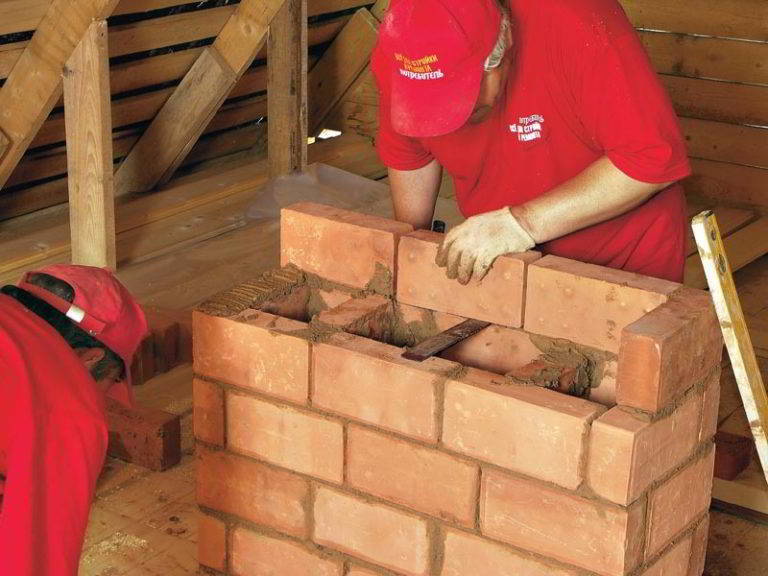

Walls "in brick" are unprofitable for two reasons - excessive consumption of materials and fuel.
The presence of holes leads to the earliest heating of the bath when the iron stove is kindled, but it threatens with increased heat, burns from the outgoing air. An alternative is the installation of metal, cast-iron doors (hatches) in the second or third row. The measure will allow you to control and manage the heating.
Recommendations
To complete you will need:
- Master OK;
- level;
- plumb line;
- container for mixing the solution.
When laying a brick around an iron stove in a bath, you should adhere to the following tips to ensure durability:
- The thickness of the seam (0.5) "in a quarter of a brick" should include a reinforcement mesh or wire 3-4 mm.
- It is necessary to adhere to the distance from the masonry to the wall of the metal stove for the bath - 3-10 cm.
- The completion of the laying of each row must be accompanied by a check of the verticality of the structure with a plumb line.
- The rows are laid horizontally in level.
- Excess mortar is removed with a trowel (outside and inside).
- If the firebox is equipped with a convection casing, remove it.
- Stoves with a thin top sheet are lined so that there is access for replacing it in case of burnout.
Varieties of partitions
Depending on the functional purpose and configuration, the screens are conventionally divided into the following types:
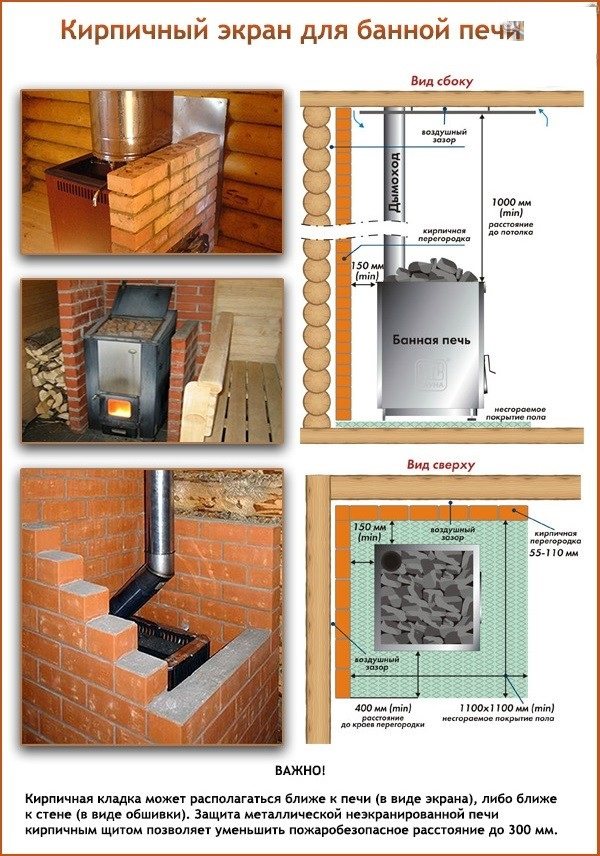

Brick protective screen for the oven.
- Protective partitions. Protect people from direct exposure to radiant heat.
- Fire screens. They are built between a wooden wall and a stove in accordance with the requirements of regulatory documents.
- Decorative. They are made in the form of a semicircle or in the form of arched vaults over steel furnaces made of pipes.
A fire shield is in any case necessary for fencing wooden structures, even when the sauna stove is equipped with a metal casing. The rules allow the use of ordinary sheet metal for this purpose, but a brick partition will look much more aesthetically pleasing.
Lining homemade heaters of different designs with bricks is a way to successfully tile them, since such products do not shine with beauty. If the heat source is welded from a vertical pipe, a round shield can be built around it. A brick arch is being built over the horizontal pipe.
Cover for finishing
Non-cladding design requires perfect geometry.
Before you impose a brick on the iron stove of the bath, you should take care of the spacers. They are objects (thickness 0.5 cm). They are laid between the rows as supports.
Excess mortar is unacceptable from the outside. It is important that there are indentations.
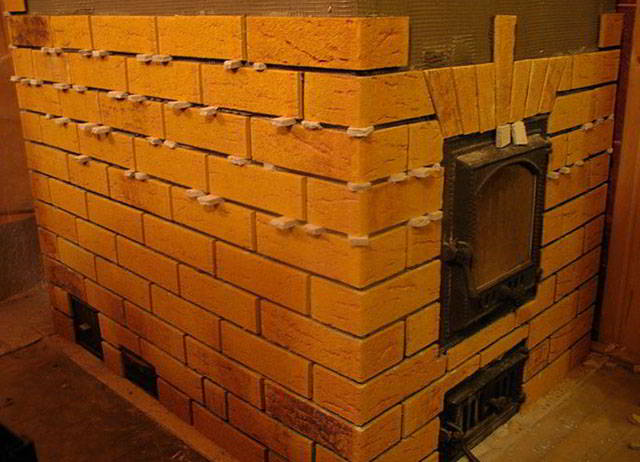

After hardening, the spacers are removed, and the outer cavities in the seams are rubbed with the same solution. It is allowed to introduce gypsum or dye into its composition, which will shade the joining. The next day, stains from the solution are removed with a stiff brush using a soap solution or rubbed with a drill with a brush attachment.
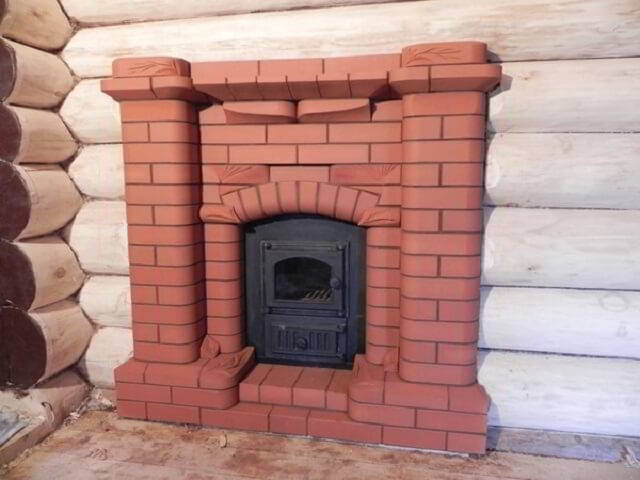

Professional advice
- Before preparing the solution, the clay should be soaked for 24 hours, and then rubbed through a fine sieve. The sand should also be sieved. There should be no stones or debris in the mixture.
- Before laying, bricks must be moistened with water. This will increase the reliability of their coupling.
- During the construction of the stove, it is periodically necessary to check the correctness of the horizontal and vertical rows using the building level.
- The best option if all metal elements of the stove are cast iron. This material withstands heat well and does not burn out like steel.
A brick oven will be the best solution for a bath. There are several types of them - from simple to relatively complex, equipped with a stove, water tank, etc. You can fold the stove yourself. To do this, you need to have some skills, and before work, draw up a drawing-order of the structure.
Watch the published video. It describes in detail how to build a bath stove out of bricks:
Features of the lining of the stove installed on a wooden floor
This method is not recommended as the presence of a foundation ensures the strength of the structure.
If this is not possible, then it is required to assess the bearing capacity of the floor. Logs (beams) should be located at a distance of 0.6 m. Length - no more than 3.5 meters. This is if beams (logs) with a section of 200 mm are laid. Boards less than 50 mm thick do not have sufficient flexural strength, so they must be thicker and less than 2 m in length.
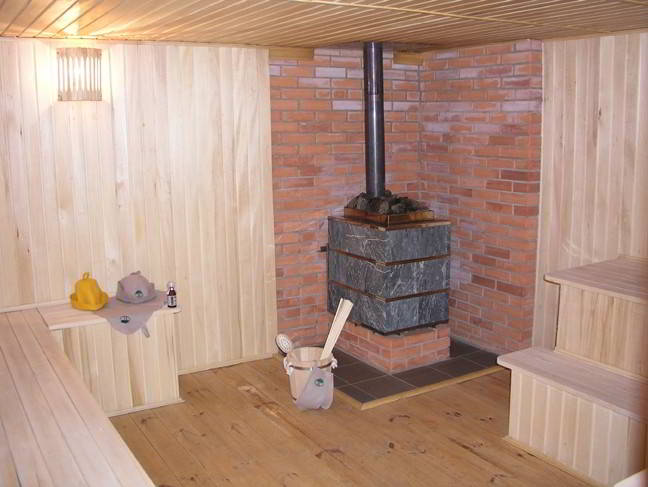

When performing work without dismantling the wooden floor and foundation, you must adhere to the following recommendations:
- The gap from the wooden walls of the room (steam room) and the lined stove of at least 10-15 cm will ensure fire safety.
- The gap to the walls of the furnace of 90-120 mm will eliminate the risk of fire due to the imminent failure of the furnace.
Types of stoves for a bath
There are 4 types of sauna stoves:
- Traditional buildings are fired in a “black” way - they do not have a chimney. They are believed to be the source of the highest quality vapor and aroma. However, when using it, you have to wait until the fuel burns out completely.
- Sauna stoves have a "gray" chimney. They are more economical than the first type, as they warm up quickly. However, soot settles in such a unit. Because of this, you also have to wait until the fuel has completely burned out.
- White stoves are the most environmentally friendly, as the bath is not polluted. However, they warm up the stove for a long time - up to half a day. This is due to the fact that its metal floor slab heats up. But such units retain heat for a long time.
- Stove with a water tank and a stove, which are placed on cast iron plates. The structure can not be closed completely. Then the bath will warm up faster. The tank is closed from the sides and back with a brick screen. The tank can be placed above the fuel chamber, and the heater can be placed under the chimney.
Calculation of material consumption
The base can be calculated empirically. The first row of bricks is laid on top of the continuous "dry" layer, their number is determined by height. It is formed by adding the width of the brick block and the masonry joint (5 mm). A column is built, having previously laid five-millimeter objects between the blocks.
It remains to add the number of blocks:
- grounds;
- each row;
- elevation of the front plane (if planned).
The mass is determined by multiplying the resulting quantity by the mass of one block. The calculation assumes the inclusion of the mass of the solution.
The volume is calculated as follows:
- Add two brick lengths and heights.
- The resulting length of the perimeter of contact with the solution is multiplied by the thickness of the solution layer (5 mm).
- The consumption is multiplied by their number.
Having received the volume, you need to calculate its weight. To do this, multiply it by 1.6. This is the bulk density of one cubic meter of solution. Adding all the values together will give the required value. Dividing it by the area of the base, the load is obtained in a numerical value per square meter. And if it is less than 1.7 t / m2, it is impossible to impose a brick on an iron stove in a bathhouse on a wooden floor without destruction.

